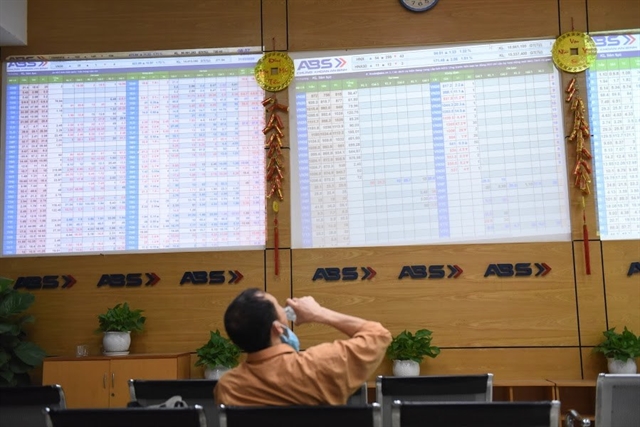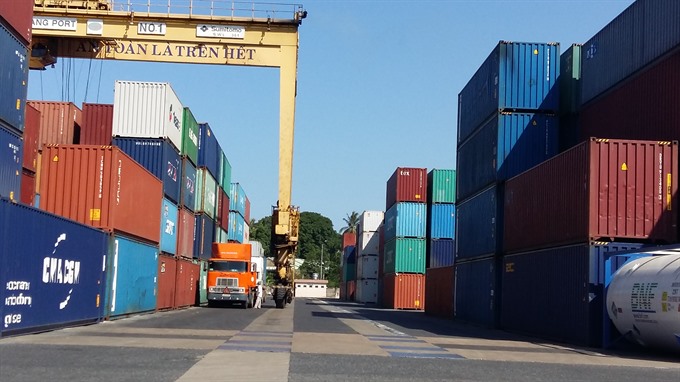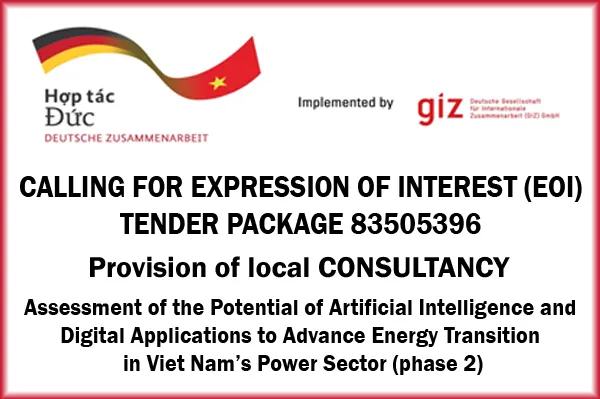 Economy
Economy

The central city plans to build a logistics complex to position Đà Nẵng as an international-standard logistics centre for Việt
 |
| A crane loads cargo at Tiên Sa Port’s container yard in Đà Nẵng. The city plans to develop a logistics complex with total investment of US$620 million. — VNS Photo Công Thành |
ĐÀ NẴNG — The central city plans to build a logistics complex to position Đà Nẵng as an international-standard logistics centre for Việt
The complex will be located in the northwest part of the city on 312ha with total investment of VNĐ14 trillion (US$620 million).
The decision was announced at the city’s people’s council meeting in July. Đà Nẵng’s complex will include a series of logistics centres linked by a system of roads and rail lines. The major nodes in the complex will be the newly designed Liên Chiểu deep-sea port, Hòa Nhơn; the newly built Kim Liên railway station; an airport and hi-tech park with international-standard warehouses; an inland clearance depot railway and entry point to road connections.
Vice chairman of the city’s People’s Committee Đặng Việt Dũng said the city intended to build the Liên Chiểu port as a key entry point into logistics chains providing services for the central and central Highlands regions, as well as the import-export exchange among ASEAN partners via the East-West Economic Corridor (EWEC) that links Việt Nam, Laos, Thailand and Myanmar.
“We aim to build up Đà Nẵng as a regional logistics centre to meet import and export needs among domestic and foreign direct investment enterprises. Partners in ASEAN could boost trading with Vietnamese businesses along the EWEC transport system and via Đà Nẵng ports,” Dũng said.
“The logistics complex will provide 50 per cent of logistics services via the airport and sea ports and 40 per cent via the railway system by 2050,” he said.
He added that a single railway line will be built to connect the Kim Liên cargo railway station with the airport cargo logistics and high-tech park. A road system will link the National Highway No 1 with Liên Chiểu port.
General director of Đà Nẵng port joint-stock company Nguyễn Hữu Sia said the city has potential to develop into a key logistics centre of Việt
“The city is situated in central Việt
‘The city also has a deep-sea port system and well-invested infrastructure in connection with the newly-built Đà Nẵng-Quảng Ngãi Expressway, the north-south national highway and railway system,” he added.
He said the sea port system, which was designed for handling 12 million tonnes of cargo each year, currently hosts 23 cargo ships from 15 shipping agencies from Europe, the US, Hong Kong and Singapore per week.
Tiên Sa port alone could allow access to 70,000DWT (deadweight tonnage) ships, 4,000TEU (twenty-foot equivalent units) container ships and 150GT (gross tonnage) cruise ships, he added.
Sia said the city’s port system, including Tiên Sa, Liên Chiểu and Sơn Trà, would handle 29 million tonnes of cargo by 2030, while the port’s warehouse could accommodate 500 TEU.
As planned, the city will upgrade Liên Chiểu port as an integrated port to ease the overloading at Tiên Sa – which will handle mainly cruise ships and fewer cargo ships. Liên Chiểu is scheduled to begin operation as a cargo port in 2022.
Sia, however, said that one major challenge was the poor quality of some 1,450km of roads on the EWEC transport corridor. This meant cargo transported via the road system to the Đà Nẵng port was limited. According to a report, only 3 per cent of cargo from the EWEC is cleared via the Đà Nẵng port, while tourism linkages between
According to the Economic Research Institute for ASEAN and East Asia (ERIA), smoother traffic and procedures on the 1,450km road of EWEC will help Đà Nẵng boost its Regional Gross Domestic Products by 2.29 per cent more than current projections for 2025.
Poor service
Director of the Joint-Stock Transimex-Sài Gòn Corporation, Đà Nẵng branch, Nguyễn Tấn Mẫn said Đà Nẵng and the central region lacked completed logistics centres as well as international standard storage.
“We have not yet seen logistics providers that could supply comprehensive services from manufacturing and cargo management to forwarding to final consumers in Đà Nẵng and the central region,” Mẫn said.
“The local logistics companies could only handle part of logistics chains such as transport, customs clearance or warehouse service only. That’s the reason big investors still hesitate to pour funds into the region, or they (investors) have to use logistics service from foreign companies,” he said, adding that local logistics companies operated as sub-contractors of logistics service from foreign logistics companies.
Mẫn also pointed out that the number of international standard warehouses in Đà Nẵng and central Việt
Meanwhile, unloading services at ports in the region are seen as still poor with 10 to 15 minutes needed for unloading a container, compared to only five minutes in
He also said logistics companies had few choices for ports in the central region as Đà Nẵng was seen as the only key port where container ships can dock.
Mẫn said his company had invested VNĐ80 billion ($3.5 million) to build the first international standard cold/chilled storage space at Hòa Cầm Industrial Zone (IZ), serving local and FDI investors in the region with a high quality warehouse for worldwide exports.
The tailor-made SOP (Standard Operating Procedure) storage also provides various logistics services of air and sea freight, bulk cargo and trucks in connection with the trading route in the East-West Economic Corridor and a system of deep sea ports at Tiên Sa and Liên Chiểu, as well as airports.
According to Chairman of Việt Nam Logistics Association (VLA) Lê Huy Hiệp the central region has 20 deep sea ports, but the system only handles 55.5 million tonnes of cargo – 13 per cent of the country’s sea ports per year.
There are only 40 foreign shipping companies in Việt
Production capacity in industrial zones (IZs) across the region has not yet developed to supply enough cargo for logistics businesses.
According to Yoshitaka Kurihara, senior advisor to the Japan External Trade Organisation (JETRO) HCM City Office, chaotic road traffic, slow rail traffic, a shortage of warehouse space and poor condition of seaports preclude investment.
As scheduled, Đà Nẵng has been working with Japanese consultants to develop the first stage of the
It is expected that the Liên Chiểu Port, which currently handles 50,000 DWT (deadweight tonnage) container ships, will be able to handle 100,000 DWT ships with a loading capacity of 8,000 twenty-foot equivalent unit (TEUs) starting from 2025. — VNS




